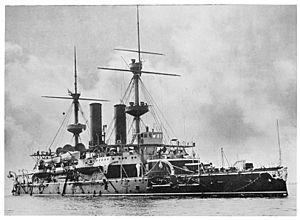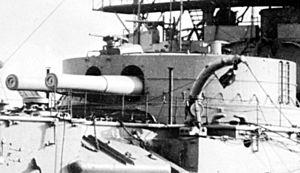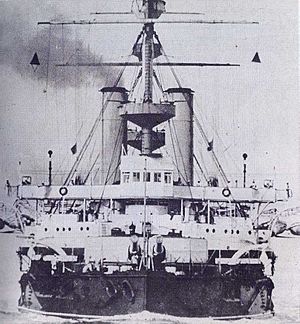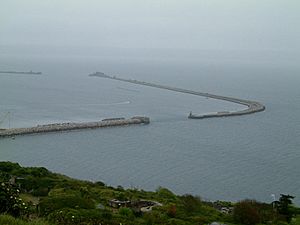HMS Hood (1891) facts for kids

HMS Hood in the 1890s
|
|
Quick facts for kids History |
|
|---|---|
| Name | Hood |
| Namesake |
|
| Ordered | 1889 |
| Builder | Chatham Dockyard, England |
| Cost | £926,396 |
| Laid down | 12 August 1889 |
| Launched | 30 July 1891 |
| Christened | Viscountess Hood |
| Commissioned | 1 June 1893 |
| Decommissioned | March 1911 |
| Fate | Sunk as a blockship in Portland harbour, 4 November 1914 |
| Status | Wreck remains visible at Portland |
| General characteristics | |
| Class and type | Royal Sovereign-class pre-dreadnought battleship |
| Displacement |
|
| Length | 410 ft 5 in (125.1 m) (o/a) |
| Beam | 75 ft (22.9 m) |
| Draught | 27 ft 6 in (8.4 m) |
| Installed power |
|
| Propulsion |
|
| Speed | 17.5 knots (32.4 km/h; 20.1 mph) |
| Range | 4,720 nmi (8,740 km; 5,430 mi) at 10 knots (19 km/h; 12 mph) |
| Complement | 690 |
| Armament |
|
| Armour |
|
HMS Hood was a powerful warship built for the Royal Navy in the early 1890s. She was a type of ship called a pre-dreadnought battleship. This means she was built before the more modern "dreadnought" battleships came along.
Hood was different from other ships in her class. She had round gun towers called gun turrets instead of open gun platforms. She also sat lower in the water, which made her less stable in rough seas. Because of this, she spent most of her time in the calm Mediterranean Sea.
In 1907, Hood was put into reserve, meaning she was kept ready but not actively used. Later, she became a receiving ship in Ireland. In 1913, she was used for special tests to develop new ways to protect ships from torpedoes. When World War I started in 1914, Hood was sunk on purpose. She became a blockship to stop enemy submarines or torpedoes from entering Portland Harbour.
Contents
Ship Design and Features
Hood was the last of eight battleships in her class, called the Royal Sovereign-class. She was unique because she had a very low front deck, only about 11 feet 3 inches (3.43 m) above the water. Other ships in her class had much higher decks, about 19 feet 6 inches (5.94 m).
Having a low deck meant Hood got very wet in bad weather. Her top speed also dropped quickly when the waves were high. This made her best suited for the calm waters of the Mediterranean Sea. This design choice showed that having a higher deck was better for battleships. All British battleships built after Hood had high decks.
Hood had heavy, armored gun turrets for her main guns. Her sister ships used lighter, open gun platforms called barbettes. These barbettes allowed the other ships to have higher decks. The heavy turrets on Hood made her less stable.
To help with stability, Hood was designed to roll less in rough seas. However, this also made her guns less accurate when firing. In 1894, special fins called bilge keels were added to her sides. These helped her steer better.
Ship's Size and Power
Hood was 410 feet 6 inches (125.1 m) long from front to back. She was 75 feet (22.9 m) wide and sat 28 feet 6 inches (8.7 m) deep in the water when fully loaded. The ship weighed about 14,780 long tons (15,020 t) when ready for normal use. Her crew included 690 officers and sailors.
The ship was powered by two large steam engines. These engines turned two propellers. Eight boilers created the steam needed to run the engines. Together, they could produce 11,000 indicated horsepower (8,200 kW) of power. This allowed Hood to reach a speed of 17.5 knots (32.4 km/h; 20.1 mph) (knots). She could carry enough coal to travel 4,720 nautical miles (8,740 km; 5,430 mi) at a speed of 10 knots (19 km/h; 12 mph).
Weapons on Board
Hood was armed with four powerful 13.5-inch guns. These were placed in two twin gun turrets, one at the front and one at the back of the ship. Each gun had 80 shells ready to fire.
For smaller targets, Hood had ten 6-inch guns. These were placed in armored rooms called casemates on the ship's sides. Four of these guns on the upper deck were too low. They couldn't be used well in rough seas or at high speed. These four guns were removed in 1904. Each 6-inch gun had 200 rounds of ammunition.
To defend against small, fast torpedo boats, Hood carried eight 6-pounder guns. Four of these were also in casemates on the main deck and had similar problems. She also had twelve 3-pounder Hotchkiss guns.
Like her sister ships, Hood had seven 18-inch torpedo tubes. Two were underwater at the front of the ship. Four were on the sides, above the water. One was at the back, also above water. The ship also had a strong, plough-shaped ram at its front, designed to hit enemy ships underwater.
Over time, some of Hood's smaller guns and torpedo tubes were removed or moved around. This happened between 1897 and 1909.
Ship's Armor
Hood was protected by strong armor made of different materials. Her main armor belt, which protected the waterline, was between 14 to 18 inches (356 to 457 mm) thick. This belt covered the middle 250 feet (76.2 m) of the ship. It was 8.5 feet (2.6 m) tall, with much of it below the water.
Thick walls called bulkheads (16–14-inch (406–356 mm) thick) closed off the ends of this central armored area. An upper layer of 4-inch (102 mm) armor protected the ship's side above the main belt. The gun turrets and their bases were protected by 17 inches (432 mm) of armor. The armored deck was 3 inches (76 mm) thick over the engines and 2.5 inches (64 mm) thick elsewhere. At the front, it dipped down to strengthen the ship's ram.
Building and Service Life
Hood was started at Chatham Dockyard on August 12, 1889. She was launched into the water on July 30, 1891. Viscountess Hood officially named her. The ship finished her tests in May 1893. She officially joined the navy on June 1, 1893. Her cost was £926,396.
Her first job was with the Mediterranean Fleet. But this was delayed because she got a leak on June 7, 1893. This happened because of bad rivets and too much stress on the hull while she was in dry dock. After quick repairs, she left for the Mediterranean Sea on June 18, 1893. She arrived in Malta on July 3, 1893.
In May 1896, Hood sailed to Crete. She went there to protect British people during a time of trouble. Cretan Greeks were unhappy with the rule of the Ottoman Empire.
From 1897 to 1898, Hood was part of the International Squadron. This was a group of ships from several countries, including Britain, France, and Russia. They helped keep peace during a Greek uprising on Crete. The squadron fired on rebel forces and sent sailors ashore. They also blocked ports to stop fighting. By late March 1897, the main fighting ended. The squadron stayed to keep order until Crete became an independent state in 1898.
Captain Alvin Coote Corry took command of Hood in December 1898. In April 1900, she was ordered back to England. She was then put into reserve at Chatham Dockyard.
In December 1900, Hood was brought back into service. She became a guard ship at Pembroke Dock. She rejoined the Mediterranean Fleet in late 1901. Captain Robert Lowry became her commander in May 1902.
In late 1902, Hood took part in naval exercises. While leaving a harbor in Greece, she damaged her rudder on the seabed. She went to Malta for temporary fixes. Then she sailed to England for full repairs. She used her two propellers to steer the whole way.
After repairs, Hood joined the Home Fleet in June 1903. She participated in more large naval exercises off the coast of Portugal. In September 1904, another battleship took her place. Hood was then put back into reserve in January 1905.
In April 1909, Hood was refitted and partly taken apart. She then became a receiving ship in Queenstown, Ireland. This meant she was used as a floating base for sailors. In September 1910, she became the flagship for the Senior Naval Officer in Ireland. She was still a receiving ship at the same time.
In 1911, Hood was towed to Portsmouth. She was going to be sold. During 1913 and 1914, she was used for experiments. These tests helped develop new ways to protect ships from underwater attacks, like torpedoes. She was even used for secret tests of "anti-torpedo bulges."
On November 4, 1914, Hood was sunk on purpose in Portland Harbour. This was done to block the Southern Ship Channel. It was a way to stop German U-boats or torpedoes from entering the harbor during World War I. Her wreck became known as "Old Hole in the Wall." Even though she was sunk, the Royal Navy still listed Hood for sale in 1916 and 1917.
The ship's bell from the first Hood was later used on the famous battlecruiser HMS Hood. The bell has an inscription. It says it was saved from the 1891 battleship by Rear Admiral Horace Hood. He was killed in the Battle of Jutland in 1916.
See also
 In Spanish: HMS Hood (1891) para niños
In Spanish: HMS Hood (1891) para niños




